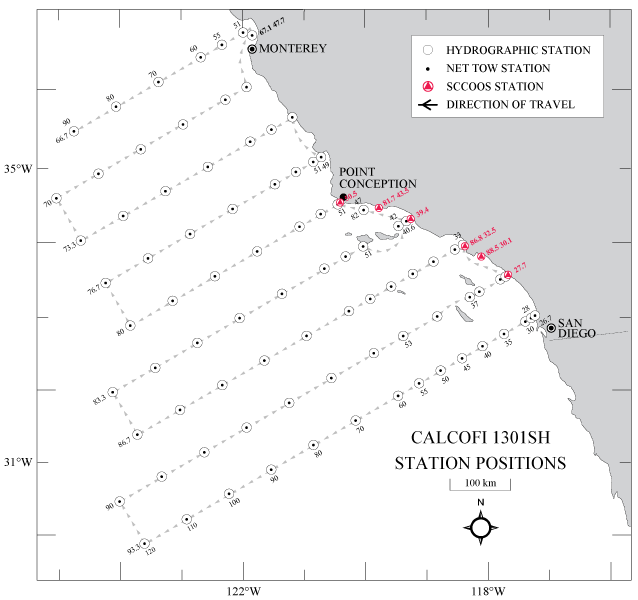| Summary: | 90 stations from line 93.3 to 66.7 (San Diego to Monterey CA): 66 standard CalCOFI stations, 6 SCCOOS stations, 18 central coast stations were sampled. CUFES underway egg sampling, SCS meterological and sea surface temperature/salinity/fluorometric data were collected during most transits. The SCS seawater pump system was secured during rough conditions. |
| Data Links: | 1301SH Seabird CTD cast files; 1301SH FinalQC bottle-corrected CTD csvs, plots, & metadata |
| Cruise Dates: | Thursday, 10 Jan 2013 - Saturday, 2 Feb 2013 |
| Loading: | Tuesday, 08 Jan 2013 - Wed, 09 Jan 2010 |
| Ship: | NOAA RV Bell M Shimada |
| Station plan: | 113 Stations (104 CalCOFI + 9 SCCOOS); NOAA 1301SH Project Instructions |
| Cruise Map: |  |
| Cruise Notes: | CTD cast notes: Station 001 - 072 were 515m (depth-permitting), 20-24 bottle rosette CTD casts.
|
| Contacts: | Dave Griffith, Chief Scientist, NMFS |
| Amy Hays, NMFS | |
| Dave Wolgast, IOD (SIO Technical Coordinator) | |
| Participants: | Griffith, Dave (Chief Scientist) | Fishery Biologist, NMFS | I & II |
| Blum, Marguerite | Oceanographer, MBARI | II | |
| Breese, Dawn | Bird Observer, FIAER | I & II | |
| Dovel, Shonna | Staff Research Associate, SIO | I | |
| Faber, David N. | Staff Research Associate, SIO | I & II | |
| Hays, Amy | Fishery Biologist, NMFS | I & II | |
| Jiorle, Ralph | Staff Research Associate, SIO | I & II | |
| Manion, Sue | Fishery Biologist, NMFS | I & II | |
| Miller, Melissa | Staff Research Associate, SIO | I | |
| Renfree, Josiah | Acoustic Technician, SWFSC | I & II | |
| Roadman, Megan | Staff Research Associate, SIO | I | |
| Roche, Lauren | Marine Mammal Observer & Acoustician, SIO | I & II | |
| Whitaker, Katherine | Marine Mammal Observer | I & II | |
| Wilkinson, James R. | Programmer Analyst, SIO | I | |
| Wolgast, David M. | Staff Research Associate, SIO | I | |
| Proposed station work: | Seabird CTD / 24 bottle rosette cast (500m depth permitting) | ||
| CTD Sensors: | Bottle Samples: | ||
| Temperature | Salinity | ||
| Conductivity | Oxygen | ||
| Oxygen | Nutrients | ||
| Fluorescence | Primary Productivity | ||
| Transmissomter | Chlorophyll-a | ||
| PAR | Phaeopigments | ||
| pH | HPLC | ||
| DIC | |||
| LTER ancillary | |||
| Nets: | |||
| CalBOBL(Bongo) net, 210m - all stations | |||
| MANTA neuston net, all stations | |||
| PRPOOS vertical net, lines 80 & 90, 86.7 & 83.3 coastal only | |||
| Pairovet vertical net, 100m (coastal stations only ( to 70) | |||
| Supplementary Data: | |||
| SCS, Underway continuous surface and meterological measurements | |||
| Primary Productivity, Daily C14-uptake incubations | |||
| Ancillary LTER , Plankton abundance, biomass, Chl a size fractionations, POC, DOC | |||
| Fisheries Acoustics | |||
| DIC, 10 stations: 93.3-30, 90-90, 90-60, 90-53, 90-30, 86.7-35, 81.8-46.9, 80-55, 80-80, 80-90 | |||
| Seabirds , Visual Observations | |||
| Cetaceans, Visual and Acoustic Surveys | |||
